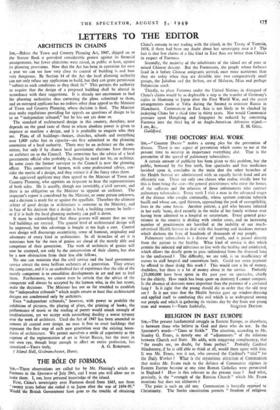TO THE EDITOR LETTERS
ARCHITECTS IN CHAINS Sm,—Before the Town and Country Planning Act, 1947, slipped on to the Statute Book it provoked considerable protest against its financial arrangements, but fewer objections were raised, in public at least, against its planning provisions. Now that the Act has been in operation for over a year we can see how very close its control of building is and how very dangerous. By Section 14 of the Act the local planning authority can not only refuse any application to build, but they can grant permission " subject to such conditions as they think fit." This permits the authority to require that the design of a proposed building shall be altered in accordance with their suggestions. It is already not uncommon to find the planning authorities thus correcting the plans submitted to them, and an outraged applicant has no redress other than appeal to the Minister of Town and Country Planning, whose decision is final. The Minister may make regulations providing for appeals on questions of design to lie to an " independent tribunal," but he has not yet done so.
The standard of architectural design in this country, therefore, now depends on the good taste of those to whom absolute power is given to improve or mutilate a design, and it is profitable to enquire who they are. Plans of all buildings—houses, churches, schools and everything over 1,000 cubic feet in capacity—are first submitted to the planning committee of a local authority. There may be an architect on the com- mittee, but only if by chance local government elections have thrown an architect on to the Council. The committee has the advice of a local government official who probably is, though he need not be, an architect. In some cases the former surveyor to the Council is now the planning officer. This committee of laymen, with some professional advice, con- sider the merits of a design, and they correct it if the fancy takes them.
An aggrieved applicant may then appeal to the Minister of Town and Country Planning, who appoints an inspector to hear the representations of both sides. He is usually, though not invariably, a' civil servant, and there is no obligation on the Minister to appoint an architect. The inspector's report is considered by the Minister, or some person unknown, and a decision is made for or against the appellant. Therefore the ultimate arbiter of good design in architecture is someone in the Ministry, and in face of his decision that a design is bad, a building cannot be built— or if it is built the local planning authority can pull it down. It must be acknowledged 'that these powers will ensure that no very bad buildings are erected. The general level of architectural design will be improved, but this advantage is bought at too high a cost. Control over design will discourage eccentricity, sense of humour, originality and adventure of every kind in architecture. In all branches of art it is notorious how far the men of genius are ahead of the merely able and competent of their generation. The work of architects of genius will now be cramped, not only by the conservatism of their clients, but also by a new obstruction from their less able fellows. No one can maintain that the civil service and the local government service attract the most brilliant architects of a generation. They attract the competent, and it is an undoubted fact of experience that the role of the merely competent is to consolidate developments in art and not to lead them. Furthermore, we cannot even be certain that the advice of the competent will always be accepted by the laymen who, in the last resort, make the decisions. The Minister has not so far troubled to establish the " independent tribunals " which might ensure at least that architectural designs are condemned only by architects.
Even "independent tribunals," however, with power to prohibit the exhibition of pictures, the playing of plays, the printing of books, the performance of music or the reading of poetry would smack strongly of totalitarianism, yet we accept with astonishing docility a worse tyranny over the work of architects. Until the Act of 1947 has been amended to remove all control over design, no man is free to erect buildings that represent the first step of each new generation over the existing boun- daries of architecture. We permit ourselves a smile of superiority at the expense of the regimentation of art in Soviet Russia, but the mote in our own eye, though large enough to affect an entire profession, lies


































 Previous page
Previous page